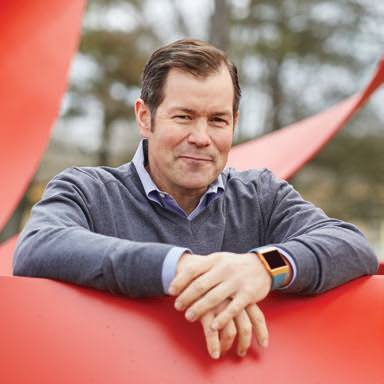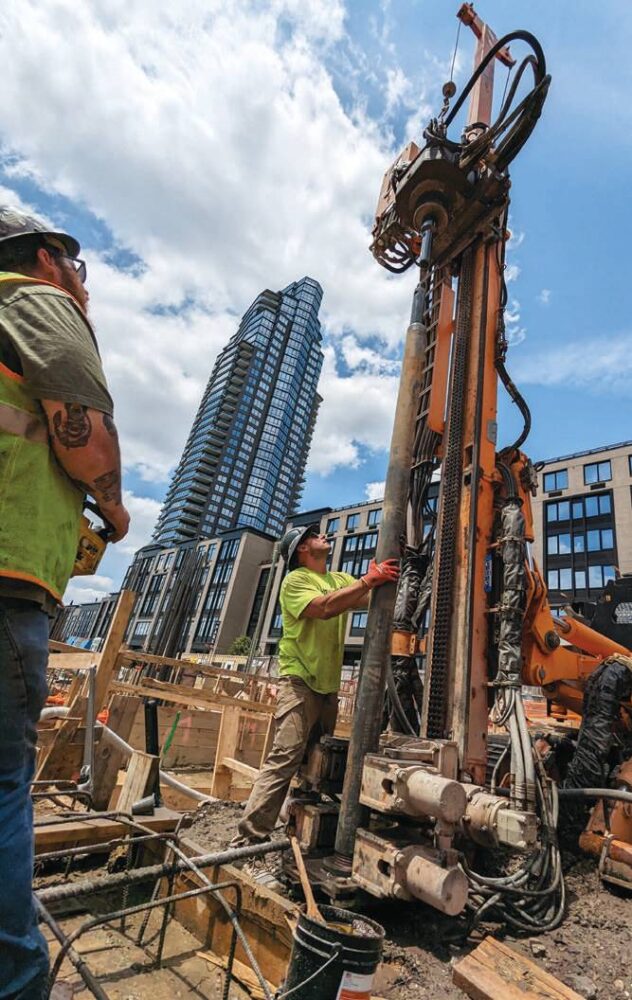Mike Richter spent his entire first career trying to prevent a certain light from going on. This was the red light behind the goal he tended as the Stanley-Cup-winning backstop of the New York Rangers from 1989–2003. That light, of course, only went on when a goal was scored against him. Today, in his second career, he helps make that light at Madison Square Garden — as well as any other power-consuming element of a commercial or industrial building — shine, with the help of clean energy.
Richter is president of Brightcore Energy, an Armonk-based company founded in 2015, that delivers turnkey energy efficiency and renewable-energy products and systems to commercial, institutional, municipal, and utility clients. Its offerings, including geothermal heating and cooling, commercial solar LED lighting, energy storage, and EV charging stations, “help our clients dramatically reduce their reliance on fossil fuels through a comprehensive approach to both energy efficiency and clean-energy resources,” the company makes clear in its mission statement. Brightcore Energy also invests its own financial capital to make energy efficiency economically valuable, which is critical to any such development.
Brightcore is just one of numerous players in Westchester County creating a more sustainable future. The reasons why are obvious to anyone paying attention to recent climate “events” — a mushy word for disasters, like excessive heat, flooding, smoky air, and others, that are becoming more frequent and severe. Richter, who studied business at Yale and has worked in the green-energy space since his retirement from pro hockey, says that our part of the world is leading the way. “New York State is probably number one in how creative it is. It has made an industry around the policies it has adopted,” he says. “Westchester County is no different. It has gone the next step.”

Photo courtesy of Brightcore Energy
“Nobody really has a great definition of sustainability or green energy, and that’s frustrating for me. I use the term ‘better’- better HVAC systems, better lighting, a more comfortable and effective and long-lasting work environment.” – Mike Richter, President, Brightcore Energy
The county has embraced the challenge, in large part because it has no choice. “Climate change is here. We need to take it very seriously and do things now,” says Bridget Gibbons, Westchester County’s director of economic development. “Westchester is so impacted by climate change. We’re surrounded by water; there’s a lot of rivers everywhere in between. We have felt the effects from Hurricane Ida and the recent storm [in September 2023]. We are living with this, and we need to address these issues.”

On site at New York’s largest geothermal heating and cooling system for a multi-use complex at Java Street, Brooklyn. Photo courtesy of Brightcore Energy.
Brightcore develops and set up end-to-end clean-energy solutions for commercial and institutional clients, often, they say, without the need for capital. They use commercially proven, off-the-shelf technologies to help clients achieve their sustainability goals, meet federal and local emissions-reduction mandates, and maximize applicable government and utility incentives.

Updated LED lights in a White Plains Public School District cafeteria. Photo courtesy of Brightcore Energy.
Madison Square Garden and Citi Field are clients; locally, and more recently, they are working with Morgan Stanley to install a 2.7 megawatt solar array over the parking lot at the firm’s office in Purchase. In addition, they have worked with the Chappaqua Central School District to retrofit its five schools with LED lighting that will result in net energy costs savings of $2.2 million over the 15-plus years of useful life, saving their clients hundreds of thousands of dollars in energy costs in the process. Most recently, they are completing what will be the largest ground source geothermal system in the history of New York State at 1 Java Street in Brooklyn for Lendlease and the first of its kind geo retrofit of a 100+ class A Coop on Manhattan’s Central Park West with their proprietary drilling technology.

Brightcore Energy’s mini-rig is small enough to fit through doorways for building retrofits. Photo courtesy of Brightcore Energy.
Richter chafes at the somewhat vague terms in this field. “Nobody really has a great definition of sustainability or green energy, and that’s frustrating for me. I use the term ‘better’ — better HVAC systems, better lighting, a more comfortable and effective and longer-lasting work environment.” Whatever it’s called, he says, the results are “good for health, good for performance, good for quality of life, good for the economy. I think it’s a moral necessity to do what you can to move society to give the next generations the same opportunities we had. If there is no fresh water left, the air is spoiled, the climate dramatically altered…there’s a level of culpability and unfairness that should be considered, whether you make financial gain out of it or not.”

More than 2,800 solar panels were installed over a Mount Laurel, NJ parking lot, offsetting approximately 80 percent of the school’s energy use. Photo courtesy of Brightcore Energy.
Public Sector
Westchester’s public sector is fully on board with making the county sustainably better. To meet the state’s initiative, the county is putting more than $30 million into electrifying its buses and garages, working with White Plains-based NuEnergen’s demand-response program to lower the county’s energy consumption when demand spikes, and has approved two new battery-storage facilities to boost infrastructure.
In addition, the county partnered with Sustainable Westchester last May to launch a Clean Energy Accelerator Program (CEA). The program, which includes a Careers Working Group, brings together employers and other stakeholders to identify the workforce needs in the clean-energy sector and create career and training pathways for Westchester residents. “One of my top priorities in 2024 is workforce development, so county residents can have these good, well-paying jobs,” Gibbons says.

Alexis Pelosi (fifth from right), senior advisor for climate, Office of the Secretary, US Department of Housing and Urban Development, toured La Mora with Mayor Mike Spano, YHA President/ CEO Wilson Kimball, and other officials. Photo courtesy of YHA.
The City of Yonkers has made headlines in sustainability recently. Last September, the Yonkers Housing Authority welcomed a visit from Alexis Pelosi, senior advisor for climate, Office of the Secretary, US Department of Housing and Urban Development. Pelosi, daughter of former House Speaker Nancy Pelosi, toured several Yonkers Housing Authority (YHA) sites, including the La Mora Senior Apartments development, now under construction. The $44 million project, in the Hollow neighborhood of South Yonkers, will create 60 energy-efficient and affordable homes for seniors. The project is one of the few modular housing sites in the country using the Passive House model, which conserves energy and is self-sufficient and hardened against weather emergencies.
“When someone sees it and understands the high-water mark is right here on this wall, they really get it. That brought home to every level of government how environmental catastrophes are coming faster.” —Wilson Kimball CEO and President YONKERS HOUSING AUTHORITY
Yonkers Mayor Mike Spano and YHA CEO and President Wilson Kimball, among others, were with Pelosi on her tour. As the first such housing in the state, “it’s generating a lot of interest,” Kimball says. “If we can demonstrate this, other people can do it.” There have been “glitches along the way,” she says, including supply-chain issues throughout the construction industry, and specifically to passive needs like specialized heat pumps and other technology. Delivery of these products was often pushed out from 180 days to 300 days. “That’s a real delay, and every delay costs money,” she says.
Other issues — inflation, high interest rates — are also driving costs up. “It isn’t going to be cheap or easy, but I think it’s necessary,” she says. “Seniors need to shelter in place if there is a freak weather event. They need self-sustaining generators for life-sustaining machines or fridges for drugs.”
Pelosi was impressed, Kimball reports. “She saw how the modules are taped together like Legos.” She also knew firsthand the impact of the September floods. “No sooner had she toured than Westchester was declared a disaster area. She had seen those places and they had five feet of water in them,” says Kimball. “When someone sees it and understands the high-water mark is right here on this wall, they really get it. That brought home to every level of government how environmental catastrophes are coming faster.”

The La Mora Senior Apartments, one of the first modular Passive House designs in the nation, currently under construction. Photo courtesy of YHA.
The YHA is also working with Sustainable Westchester to retrofit many of its housing units with solar and promote solar among its Section 8 landlords. And in November, it was one of just 88 national recipients of a $1 million grant from the Biden Administration’s 2023 Environmental Justice Government-to-Government (EJG2G) Program. Under the aegis of the US Environmental Protection Agency, the EJG2G program provides funding to support government- and community-based partnerships. The YHA, in conjunction with Groundwork Hudson Valley, will work with nonprofit partners to increase green infrastructure in its affordable housing system to address indoor and outdoor air quality, exposure to toxic pollution, water quality, access to healthy food, and affordable transportation and emergency preparedness in low-income, underserved areas that are hardest hit by environmental damage.
Addressing climate change now is not only environmentally necessary, it’s also good business, Kimball says. “Businesspeople get it immediately. It’s a dollars-and-cents fact. We need to invest in this now, because the cost later will be 10 times what we are dealing with now, maybe more.”
“Westchester is so impacted by climate change. We’re surrounded by water, there’s a lot of rivers everywhere in between. We have felt the effects from Hurricane Ida and the recent storm [in September 2023]. We are living with this, and we need to address these issues.”—Bridget Gibbons Director of Economic Development Westchester County
The Business Community
Over at the Westchester County Association (WCA), Michael Romita, its president and CEO, has a career-long interest and expertise in environmental law and energy policy; clean energy is his wheelhouse. He has helped position WCA to prepare businesses for a low-carbon future through advocacy and by providing tools and training. The WCA has hosted Westchester’s only Sustainable Business Conference for the past two years, which included a boot camp for businesses just getting started in sustainability, and it launched a Clean Energy Portal with hundreds of resources.
Success, he says, starts with the legal landscape. The New York State Climate Leadership and Community Protection Act of 2019 “is one of the most ambitious pieces of legislation in the country,” he says. “A suite of county climate laws has also been passed, mostly around electric buses, creating more charging stations and some money for climate adaptability.”

Susan Fox, president & CEO, White Plains Hospital, chair, WCA Board of Directors; Horace E. Anderson Jr., dean, Elisabeth Haub School of Law at Pace University, member, WCA board of directors; Michael N. Romita, president & CEO, WCA. Photo by Lynda Shenkman.
The region will need “massive investments in clean-energy infrastructure,” he says, and is getting a nice chunk of that from the Clean Path New York project (cleanpathny.com). The New York Power Authority and Forward Power are funding an $11 billion clean-infrastructure project that will build more than 20 wind- and solar-generation projects in New York State, including Westchester, and a new 175-mile underground transmission line. It will deliver more than 7.5-million megawatt-hours of emissions-free energy into New York City every year, while also helping the state meet its climate goals, creating more than 8,300 jobs and saving New York State ratepayers millions each year in energy costs in its first 25 years of operation. “This is a game-changer for the Hudson Valley,” Romita says.
At the local level, the Climate Smart Communities program (climatesmart.ny.gov) offers grants, rebates, and free technical support to local governments working to reduce greenhouse-gas emissions. Other initiatives include a Real Estate Policy Playbook the WCA produces, which is adding chapters specifically on climate adaptation, and a Sustainability Business Conference called Profit and Purpose, with Pace University Law School, that offers workshops, expert advice, symposiums, and work groups on the topic. “We got ideas there that caused us to launch the portal and change our policy playbook,” he says.
Still more needs to be done. “The county budget has $50 million for flood mitigation, which is probably one-tenth of what’s necessary,” he says. “Walk around the flats in Mamaroneck or Main Street in Rye after a big storm and you’ll get a taste of what businesses are struggling with. Businesses need to get behind the concepts of the Climate Act of 2019 and not stick their heads in the sand. The ostrich strategy is not going to work. Climate change is real, it’s coming, and businesses need to prepare.”
The Real Estate Sector
One challenge unique to Westchester is adapting existing and new real estate to higher sustainability standards, because, according to Romita, “It’s incredibly expensive here.” Developers are taking on the challenge in projects like The Halden, an upscale, 303-unit apartment complex on Westchester Avenue in White Plains. The NRP Group and RPW Group are behind the project, which includes a solar panel array on the roof. “One of the most exciting features of this project is the inclusion of solar panels designed to generate clean energy, which directly aligns with the City of White Plains sustainability values,” White Plains Mayor Tom Roach said in a statement.
The solar-panel installation generates more than 500,000 kilowatts of clean electricity, and residents can purchase power generated on site at a discount to the standard market rate.

Left to right, back row: Robert Weisz, CEO and chairman, RPW Group, Inc.; Jonathan Gertman, senior vice president of development, The NRP Group; Andrew Weisz, president, RPW Group, Inc.; Thomas Roach, mayor, City of White Plains; Christopher Gomez, commissioner of planning, City of White Plains; front row: Bridget Gibbons, deputy director of economic development, Westchester County; Victoria Presser, council member, City of White Plains. Photo by David Miller Studios.
The RPW Group has another solar project going — installing solar-topped carports on underused parking lots. White Plains officials have worked with the company to amend setback easements and streamline the approval process to allow this work, says Andrew Weisz, president of RPW Group. The lot owners lease their space to G&S Solar to install the panels and can choose to use the energy directly or sell it back to the grid.
The company has adopted other energy-saving practices in its buildings, Weisz says, such as responding to high-demand times by lowering cooling, turning off some lights, or shutting down an elevator. “Our customers are very amenable and supportive,” he says. They are also using more recycled building products and partitioning materials for eco-friendly disposal. “In the grand scheme, these are pretty quick and effective ways” of creating clean energy and reducing energy use, he says. “For the viability of our environment and well-being of future generations, we need to take action now.”
“For the viability of our environment and well-being of future generations, we need to take action now.” —Andrew Weisz, President, RPW Group
RXR, another developer, is behind the Hamilton Green project, which is repurposing the White Plains Mall into transit-oriented housing. The project is designed as a LEED Silver building, in line with Energy Star Standards, and seeks to achieve the WELL Health + Safety certification upon opening, says Joseph Graziose Jr., executive vice president, RXR Development Services. Hamilton Green will also use smart-glass technology in its façade by automatically adjusting to minimize heat and glare, which will reduce energy consumption.
“We also plan to implement meaningful sustainable design features, specifically an all-electric-ready infrastructure, smart-home technologies utilizing intelligent thermal controls, and high-efficiency mechanical systems to further promote health and wellness for the building and its tenants,” he says.
According to Graziose, Jr., the pandemic increased interest in health and wellness, which includes sustainability and environmental concerns. “Since COVID, both residential and commercial tenants have shown more interest in our health and wellness offerings,” he says. “When New Rochelle became the epicenter of the pandemic in the United States, we knew we had a responsibility to build buildings that incorporate health-forward measures such as highly rated ventilation systems, plentiful open space, and programming that encourages healthy living. And, as climate change and extreme weather pose challenges to our assets, we’ve implemented thorough risk-management practices to assess the risk of each building and recommend actions to improve resilience.”
Graziose, Jr., says that RXR “is committed to reaching carbon neutrality by 2035 and achieving net zero carbon emissions by 2050,” through electrification, efficient technology, waste diversion, and more. “Across our operating assets, we’ve made strides since 2019 to reduce our energy usage and greenhouse-gas emissions. Each asset is governed by an individual business plan, which helps position our assets to be fueled by a zero-emission electric-power source. These initiatives have resulted in a 20 percent energy-use-intensity reduction and a 50 percent reduction in greenhouse-gas emissions in the last four years.”
Energy Providers
Individual energy companies, like Robison in Port Chester, also see the need for — and the business opportunity in — clean energy. This past summer it began delivering a new, cleaner form of heating oil called B20 biofuel. President and CEO Dan Singer says the company is among the first in the area to offer the fuel, which is a blend of 80-percent regular heating oil and 20-percent biodiesel. Biodiesel is made with vegetable oil such as soybean oil, which burns cleaner than regular heating oil and is a renewable source of energy that reduces US dependence on foreign oil.
The statewide transition to B20 fuel is estimated to reduce fossil-fuel consumption by approximately 200-million gallons and reduce greenhouse-gas emissions. To spark this fuel transition, the state is offering a 20-cent-per-gallon direct tax credit for every gallon of fuel consumers use; thus, for every 1,000 gallons of B20 blend used, a homeowner would save $200. “This fuel is totally safe to use without having to make any modifications on your burner or tank, and there is no need to buy new equipment,” Singer says.

Courtesy of Robison
Robison also installs and services air-sourced and geothermal heat pumps that help reduce or eliminate fossil-fuel usage. The company’s embrace of green energy is partly customer-based. “Customers want to reduce their use of carbon. Moving to B20 biofuel is one way Robison is addressing what customers want,” Singer says. But it’s also part of the company’s mission. “Some customers complained about the switch to B20 and demanded Robison revert to delivering conventional heating oil. Robison did not relent and invited such ‘climate deniers’ to take their business elsewhere,” he says. “We are members of this planet and of this community. Robison wants to be a part of providing homeowners the opportunity to reduce their use of carbon-based fuels. Our company image is evolving from a ‘dirty oil company’ to a forward-thinking ‘home-comfort company’ with environmentally friendly heating solutions for homeowners.”
“Our company image is evolving from a ‘dirty oil company’ to a forward-thinking ‘home-comfort company’ with environmentally friendly heating solutions for homeowners.” —Dan Singer President and CEO ROBISON OIL
Nonprofits
Among the nonprofits, Sustainable Westchester is arguably the county’s leading advocate for climate-change adaptation. The organization, a consortium of local governments, helps members achieve the goals of the Climate Act by supplying large-scale renewable electricity, implementing clean-energy solutions, increasing efficiency, and promoting environmental justice through economically viable actions.
“We expect the transformation of fleets will happen extremely rapidly in the county and the state, like when smartphones took over.” —Leo Wiegman Director of solar programs Sustainable Westchester
The group works with all 45 cities, towns, and villages, and the county itself, says Leo Wiegman, Sustainable Westchester’s director of solar programs. It fosters numerous initiatives, such as Westchester Power, New York’s pioneering and longest-running Community Choice Aggregation (CCA) program, that supplies 100-percent renewable electricity to more than one third of county households; upgrading antiquated commercial heating and cooling systems with modernized electrical heat pumps; EnergySmart Home improvements; community solar projects; and increasing electric-vehicle-charging infrastructure across Westchester.
Westchester Power, launched in 2016, is its largest program, with 29 municipalities participating, including Yonkers, according to Wiegman. It provides about 120,000 customers with renewable energy as “a way of providing price security,” he says, with rates fixed for 18 to 24 months.
Wiegman foresees big gains in carbon reduction in the two areas that produce the most greenhouse gasses: transportation and construction. In the former, vehicle electrification will play the biggest role. “Westchester County is rapidly increasing its electric-vehicle [EV] count. There are almost 13,000 EVs in the county.” Most are personal vehicles, he says; “half of those are Teslas.” But county and municipal governments are also electrifying their fleets, as are some corporate entities, such as UPS and Amazon. “We are just at the tip of the iceberg on this. We expect the transformation of fleets will happen extremely rapidly in the county and the state, like when smartphones took over,” he says. He expects new car sales to be almost 100-percent electric in 10 years, compared to only 10 percent now. “And you won’t be able to buy a fossil-fuel school bus in a couple years,” he says.

Members of Sustainable Westchester team toured the new solar canopy at the Gedney Recycling Yard in White Plains. Photo courtesy of Sustainable Westchester.
Sustainable Westchester is putting its efforts into charging stations to reduce range anxiety and encourage the public to move to EV, says Wiegman. “We are looking for mass deployment, collaborating with facilities owners who could have public-access charging stations in a public parking lot or garage, for example.” The organization is less concerned about the suburban homeowner who can run an outlet to their garage. “We are focusing on charging in urban areas, where EV uptake will grow the fastest as lower prices come online and they need more common, accessible charging points. Then apartment and condo dwellers can trade in their 12-year-old car for an EV and not worry about charging.”
In the construction space, the county, as a NYSERDA Clean Energy Hub, uses grant money to work with the Cornell Cooperative Extension to deploy technical assistance and advice to any home or business owner, free of charge, if they want to, say, replace an old oil furnace with something greener. “It’s one homeowner, one business owner at time. Sometimes a small-dollar project, sometimes a big-dollar project. We are there to present information and connect them with programs and installers with good reputations,” Wiegman says.
In solar power, “there are three things happening at once,” he says. The first is advising homeowners who are considering solar. “It’s like when you were a teenager buying your first car, you’d ask Uncle Tony, ‘What should I buy?’” he says. “In solar, no one has an Uncle Tony, so we are Uncle Tony. We assess and advise you what to expect for your house, to help individuals be smarter consumers.”
Part two is encouraging those who can’t install solar, for whatever reason, to subscribe to a community solar project. “We have an active subscription program with about 3,000 people enrolled, and they get a discount of 5 to 10 percent on their energy bill,” he says.
Finally, they are identifying sites that could host solar and encouraging property managers or owners who are interested in hosting a solar farm. These are typically large commercial sites with big parking lots. “The owner could decide to have a company install solar canopies in parking lots and send the energy to the grid. You can lease air rights over the lot, and people can park under the canopy. Or you can be an anchor subscriber of some or all of the project, perhaps use 40 percent of the solar energy for your buildings, maybe the rest goes to employees who park there, or you can send the rest to a community project. There are three or four different ways to arrange it under current regulations. And the financing has never been better. With federal and state incentives, you have no expenses other than having an attorney read the lease.”
A Growing Opportunity
Sustainability is both imperative and financially sound, a win-win if ever there was one. Richter says he is “bullish on this opportunity. It is massive and still growing. We must educate the public and deploy, deploy, deploy.”
No one is cheering him like they did when he prevented that red goal light from shining at MSG, but he is as committed to this career as he was to his athletic endeavors. “When I retired, someone said, you have to do something really meaningful. What I’m doing now is something the world has to get right,” he says. “We must live within the resources we have. I think we can do that in ways that bring a better environmental world, more comfortable buildings, and a better climate. To go to work making an important difference, improving our clients’ lives and society, that’s a pretty great thing to get up and do every morning.”

Photo by Toshi Tasaki
“When I retired someone said, you have to do something really meaningful. What I’m doing now is something the world has to get right.” — Mike Richter President, Brightcore Energy
Freelance writer David Levine is a frequent contributor to 914INC.
Click here to read the article on Westchester Magazine’s site.


